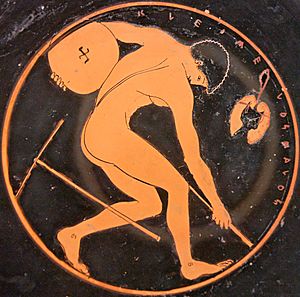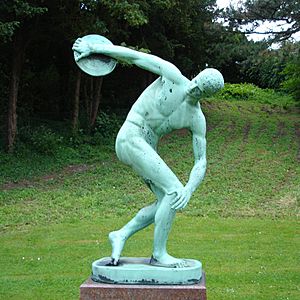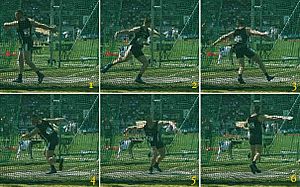Discus throw facts for kids
The discus throw is an exciting event in athletics. It involves throwing a heavy, flat disc as far as you can. This sport started way back in 708 BC in Ancient Greece. The main goal is simple: throw the discus farther than anyone else!
Many famous ancient Greek statues and Roman copies show discus throwers. One amazing athlete, Al Oerter from the US, won the same Olympic event four times in a row. That's a huge achievement!
Contents
History of the Discus Throw

The discus throw is a common part of most modern track and field events. It's also a very famous sport at the Olympic Games. Men's discus has been in the modern Summer Olympic Games since the very first games in 1896. Pictures of discus throwers were often used in early Olympic ads, like on stamps for the 1896 games and posters for the 1920 and 1948 Summer Olympics.
The discus sport was "re-discovered" in Magdeburg, Germany, by Christian Georg Kohlrausch and his students in the 1870s. They studied old throwing techniques.
The first modern athlete to throw the discus by spinning his whole body was František Janda-Suk from Bohemia (which is now part of the Czech Republic). He came up with this new way of throwing after looking at the famous Discobolus statue. After just one year of practicing this spin technique, he won a silver medal at the 1900 Olympics!
Women's discus was added to the Olympic Games in 1928. However, women had been competing in discus at other national and regional events before then.
What is a Discus?

A discus is a round, flat disc. The men's discus weighs 2 kilograms (4.4 lb) and is about 22 centimetres (8.7 in) across. The women's discus weighs 1 kilogram (2.2 lb) and is about 18 centimetres (7.1 in) across.
For younger athletes, the weights are different:
- Youth boys (16–17 years old) throw a 1.5 kilograms (3.3 lb) discus.
- Junior men (18–19 years old) throw a 1.75 kilograms (3.9 lb) discus.
- Girls and women of those ages throw the 1 kilogram (2.2 lb) discus.
Most discus discs are made of plastic, wood, fiberglass, carbon fiber, or metal. They have a metal rim and a metal core to give them the right weight. The rim must be smooth. A discus with more weight in its rim spins better and flies more steadily. This can help it go farther if thrown correctly.
How to Throw the Discus
To throw the discus, the athlete stands inside a circle that is 2.5 meters (about 8 feet) wide. This circle is slightly lower than the ground around it. The thrower usually starts facing away from where they want the discus to land.
They then spin around one and a half times inside the circle. This spinning helps them build up speed and power. After spinning, they release the discus. It must land within a special marked area, which is a 34.92-degree sector.
The rules for discus throwing are similar to those for shot put. The main differences are that the discus circle is bigger, and there's no stop board at the front. Also, there aren't strict rules about how the discus must be thrown, as long as it's done correctly.
The distance is measured from the front edge of the circle to where the discus lands. Distances are rounded down to the nearest centimeter. Athletes usually get three to six throws. Their best legal throw is recorded. The person who throws the discus the farthest wins! If there's a tie, the athlete with the longer second-best throw wins.
The basic throwing motion is a sidearm swing. The discus spins off the index or middle finger. For a right-handed thrower, the discus spins clockwise in the air. For a left-handed thrower, it spins counter-clockwise.
Getting the discus to go far depends on several things:
- How much speed the thrower gives it.
- The angle at which it's thrown.
- How well the discus flies through the air.
Throws often go farthest when there's a light headwind. A faster-spinning discus is also more stable in the air. Learning to throw the discus well takes a lot of practice and experience. That's why many top discus throwers are 30 years old or older!
Phases of a Discus Throw
The discus throw can be broken down into different steps or "phases." The main goal is to move from the back of the circle to the front while spinning one and a half times. The throw starts slowly and builds up speed. Good technique means building up a lot of twisting force (torque) so that maximum power can be used when the discus is released.
During the wind-up, the thrower's weight is balanced between their feet, which are about shoulder-width apart. This part sets the rhythm for the whole throw, which is very important.
Having a good rhythm helps athletes get into the right positions consistently. To throw the discus well, you need excellent balance. This is because the throw involves moving forward, spinning, and holding a heavy disc in one hand. So, a good discus thrower must stay balanced inside the circle.
For a right-handed thrower, the next step is to shift weight onto the left foot. Then, the right foot lifts, and the athlete "runs" across the circle. There are different ways to do this, but the goal is to land in the "power position."
In the power position, the right foot should be in the center of the circle, and its heel should not touch the ground. The left foot should land very quickly after the right. Most of the weight should be over the back foot. The body should be twisted as much as possible, with the right arm high and far back. This position is hard to achieve! Power position.
The most important part is the delivery of the discus. From the power position, the hips push hard forward. They will be facing the direction of the throw when the discus is released. After the throw, athletes use different ways to stop and recover, like planting their feet or spinning onto their left foot.
A sports scientist named Richard Ganslen studied how the discus flies. He found that the discus will lose lift and drop (stall) if it's thrown at an angle of 29 degrees.
Discus in Culture
The discus throw has been shown in many famous ancient Greek statues and Roman copies, like the Discobolus and Discophoros. It also appears often in ancient Greek mythology.
Discus throwers have been featured on many collector's coins. For example, Greece minted a special €10 Discus commemorative coin in 2003. This coin celebrated the 2004 Summer Olympics. On one side, it shows a modern athlete throwing the discus. In the background, an ancient discus thrower is shown in a lively pose, holding the discus high above his head. This creates a cool picture of the sport's past and present.
Related pages
Images for kids
-
The main poster for the 1920 Summer Olympics
-
Discus (2 kg), IAAF certified for competitions
See also
 In Spanish: Lanzamiento de disco para niños
In Spanish: Lanzamiento de disco para niños






